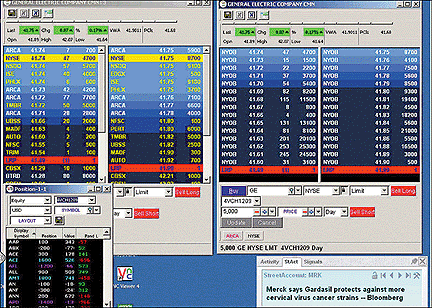Since You Asked
| Confused about some aspect of trading? Professional trader Don Bright of Bright Trading (www.stocktrading.com), an equity trading corporation, answers a few of your questions. | 
Don Bright of Bright Trading |
TAPE READING ON THE INTERNET?
I am a Chinese student who graduated from university four months ago. Now I have a daytrading job. I concentrate on the NYSE stock market and my trading style is scalping. So tape reading is very important for me. But I find it's hard to get this type of article from the Internet. I hope you can help me and send me some information to improve my tape-reading skills (Level II and time & sales reading is best, because I can't read the chart), or tell me how to find this sort of information. Thank you. -- lacan
Okay, we teach "all-encompassing" tape reading. This includes keeping a Prem/Disc to fair value tick chart, real time, for the emini futures. Basic market mechanics dictate that when you see futures trading at a premium to the current-day fair value, the floor traders and other institutional trading groups will be selling that premium and hedging off by buying baskets of stocks, or even all 500 underlying equities. We keep track of NYSE ticks (net uptick vs. downtick) and look for reversal points (generally above 800 positive or negative). We post our pivot points every day, and keep the trading troughs in mind. You can check www.stocktrading.com/Tradinginfo.htm to see this information that I post daily for our traders.
I keep two montages open. Figure 1 shows an image here with Level II
and the New York Open Book.

FIGURE 1: TWO MONTAGES. Here are two montages, one with Level II and the other with the New York Open Book.
This gives us a good view of the depth of book and open pricing
areas to enter our "outside enveloping" orders, which help us take part
in hybrid sweeps. I also keep a basic "last trade price and size" ticker
running so that I can see what is actually trading versus all the noise
in the bid/offer changes.
In addition, we show the basic setups, cleanups, and identification views. We also show how to identify a strong buyer or strong seller by using fishing orders, identifying intraday tops and bottoms, checking for institutional involvement compared with market noise, and so forth.
Tape-reading skills are like driving skills. If you try to identify each and every thing you're looking at, it's tough at first. But when you have it somewhat mastered, it's just second nature. Hope this helps.
ABOUT IMBALANCES
Hi, Don, from your postings, I view you as quite experienced and a knowledgeable fellow. I pose a question, probably rather simple from your perspective, but difficult from mine: What significance does the 3:40 pm ending order imbalances entail for daytrading? Also, can you recommend any books that will expound on the subject? Thank you in advance. --trad2ing
MOC (market on close) imbalances are fundamental to all types of trading. There's quite a bit to it, but as far as a basic concept goes for "day" trading, here's a scenario. Suppose you're trading all day long, and you're long 2,000 shares at 3:30 or so. You think you want to get out, but you might wait until 3:40 to see if there is a buy or sell imbalance. If it's a buy, wait; if it's a sell, sell immediately. Of course, you'll have to monitor each of your "children" (stocks you trade day in and day out) during all the time frames near the end of the day -- 3:30, 3:40, 3:50 (republish), 4:00 bell, and the final MOC price. I provide my traders with software to do that for them (with futures as well so we can tell if price movement is related to imbalance or simply a basic market move at end of day). Hope this helps.
ABOUT CLOSING PRICES
I have a question on closing prices of the major indexes. Why does the closing price not produce the same kind of price movement as the opening? If you look at any index intraday, you will see the classic U-shaped volume pattern with the largest volume occurring at the open and the close. The opening is set by the specialists matching all the buy and sell orders in the book and sometimes they produce gaps where there are heavier imbalances between the orders, which creates bigger price concessions. I know bigger price concessions happen at the beginning of the day as the future price direction is the most unknown. But what I don't understand is why the close does not produce similar price movements to the open relative to the amount of volume that is pumped in.
I know closing orders get sent in throughout the day and at 3:30 pm, 3:40 pm, and so on. The specialist has an idea of what and where the closing is going to be like, but I know that in the last few minutes of trading before the closing bell, he gets a flood of unknown orders buys/sells, which accounts for the large amount of volume that you see on a chart but you do not see a great deal of price concession or movement being given up to accommodate that surge in orders. Why is that? --raker
Overnight there tends to be a big difference between opening price buy orders and opening price sell orders, thus giving way to a bigger gap. The market on close (MOC) price is following along with the normal market pricing near the end of day. And at 3:40 and 3:50, the specialist publishes the MOC imbalances and gets help offsetting these imbalances.
PRICE RULES
I feel that concentrating on price is for trading. Concentrating on fundamentals is for investing. Do not mix one with the other, but even when investing and the company invested in can be way overpriced, make sure it looks like price rules.
Here is a fact of life: When trading and investing with real money (paper traders never will learn this), the best lessons learned and the lessons that sink into the brain are the lessons that cost you dearly. The more you make mistakes, the lessons learned will be (better be) learned and not repeated. The easy stuff in trading is the hardest to learn -- keep it simple, stupid. Your thoughts? -- bighog
A couple of basic comments. I agree with the investing vs. trading aspect of fundamental analysis with the exception of correlated pairs trading. My brother has a good-sized chunk of our money in about 350 pairs at this point, and he actively trades 100,000 shares a day or more to keep the positions working well.
We use very detailed fundamentals for determining long vs. short stocks prior to ever putting on a trade. One of my nieces works about 30 hours per week doing research in this arena. My brother says that if we're going to own something for an hour, a week, or a year, we should feel as confident in that purchase as if we were going to hold it for 10 years or more.
Since we are accountants by education, fundamental analysis is really basic and easy for us. I suggest accounting classes for all investors/traders. In the college classes I teach, I pull the same joke on everyone (trader/accounting humor!): I ask for the students' biggest stock holdings, and they tell me. I ask them for the book value of that holding, by share. Of course they never know. Then I ask them how much their car is worth within a couple of grand, and yes, they all know that. So my response is, "Well, you know more about a $20,000 car than a $400,000 investment." That makes them start thinking.
E-mail your questions for Bright to Editor@Traders.com, with the subject line direct to "Don Bright Question."
Originally published in the June 2008 issue of Technical Analysis
of STOCKS & COMMODITIES magazine. All rights reserved. © Copyright
2008, Technical Analysis, Inc.
Return to June 2008 Contents